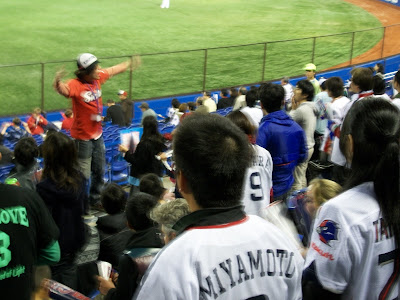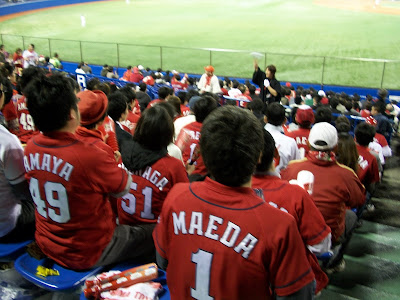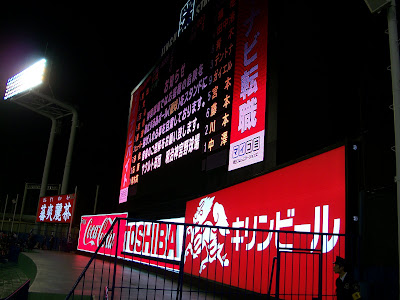Japan Trip - Besuboru!
>> Friday, April 9, 2010
Konnichiwa! Time for more adventures in Japan, today featuring my trips to Jingu Stadium, home of the Tokyo Yakult Swallows.
Japanese professional teams have, since the beginning of the Nippon Professional Baseball League, been owned by corporations which include their names in the team's official name. Yakult, for example, is not a place but a drink company, most famous for an Ovaltine-esque nutritional yogurt drink. They have lots of other products, but they are almost all drinks, making their choice of mascot--the Swallows (the kind of bird)--an unintentionally funny pun in English. The Swallows play in Tokyo, and they are sometimes called the Tokyo Yakult Swallows, but their more common name is the Yakult Swallows. The Hanshin Tigers are owned by the Hanshin Railway and Department store chain, and play in Nishinomiya. The Nippon Ham Fighters are not Ham Fighters from Nippon, but the Fighters, sponsored by Nippon Ham, who play in Sapporo. It's all pretty confusing for a non-native.
Only the Hiroshima Carp and the Tokyo Giants, to my knowledge, go by their city names--the Carp because more of their shares are owned by one family than one corporation, and the Giants because they have become synonymous with the city and are considered "Japan's team." Their hats still say YG on them though, as they used to be called the Yomiuri Giants, after the very successful Yomiuri Shimbun newspaper which owns them.
Jingu Stadium is a small ballpark with a lot of character. It opened in 1926, and actually sits on--and is the property of--the nearby Meiji Shrine. The Swallows, best I can tell, are like the New York Mets to the Tokyo Giants' Yankees. They are the other team in town, in many ways, but I like their underdog status. It's also pretty easy to get tickets to their games, as opposed to Giants tickets at the Tokyo Dome, which often sells out. The first game I went to, Jingu stadium was decked out in cherry blossom decorations, because we had just hit the peak season for sakura.
The first game, the Yakult Swallows versus the Chunichi Dragons, I sat down in the good seats, where the view of the field is terrific. There's really not a bad seat in the house, and the ballpark is small and intimate enough that I almost felt like I was at a minor league stadium--and I love minor league stadiums. The folks around me were super friendly, and appreciated that I had chosen to root for the home team.
The stands felt a little empty though, until I realized that the majority of people come to sit in the bleachers and be part of the super-charged oendan (fan clubs) that sing and dance the entire game.
From my vantage point down the first base line, I could see the Swallows oendan in right field. They sang early and often. Left field was just as full of fans, but they were there to support Chunichi. Whether they had come all the way from Nagoya in central Japan (home of the Chunichi Dragons) was unclear, although I suspect since this was Tokyo they were fans originally from the Nagoya area who have since moved to the capital. The Dragons are pretty good too; they won the Japan League title as recently as 2007.
Jingu Stadium boasts a pretty great scoreboard, which would have been lots more use to me if I could read Japanese. The animations that introduce the players are pretty cool though.
Every now and then a dance squad would come out in between innings to keep the fans pumped up. Joining them is Tsubakurou, the Swallows' famous mascot.
In the second game I attended--the Swallows versus the Hiroshima Carp--I chose to sit out with the crazy fans. I had a great time.
The guys in red are cheerleaders, in the truest sense of the word. Their job is to stand on a raised platform in the middle of the bleachers and lead the fans in preset cheers, songs, and exhortations, and everyone really does sing and dance along. The oendan is like the singing fans at European soccer matches, but far more coordinated and official about it, as you would expect from the Japanese.
The cheerleaders tape off a section of seats for their antics, and you really don't want to sit too close. You risk getting smacked in the head by a weighty flag pole...
...or getting blown away by the trumpets.
I have to admit though, they made the game a lot more fun. People still watched and were focused on the action, but the cheerleaders and the group songs and the plastic bats fans beat together to make noise really built a sense of community in the stands. As soon as you join in, you belong--a sentiment that's not universal in many of the other closed worlds in Japan.
The opposing fans get into the act as well. Here the Hiroshima fans cheer for their team while the Carp are at bat. The fans sing and chant while their team is on offense. While they're on defense, they sit and give their legs and lungs a break. They also eat. And eat. And eat.
A Hiroshima cheerleader, at top, in a black happi, a long-sleeved coat with the team crest on it.
The Carp fans have a great cheer where half of them sit and half of them stand, back and forth, over and over again. It's really great to watch.
I liked this guy's happi, which had the word Hiroshima in the shape of a carp.
Fans on both sides take advantage of Jingu Stadium's neat picnic area at the top of the outfield bleachers, where they spread blue tarps just as they do under the cherry blossoms.
When the Swallows score, the fans break out tiny plastic umbrellas and raise them in song.
They used to blow up condom-shaped balloons and set them off for home runs and for the seventh-inning stretch, and some teams still do that. Others, like the Swallows, have outlawed them following the H1N1 scare. A bit of overkill, really, but this is a country where people wear surgical masks around when they get a sniffle, so it really shouldn't come as a surprise. This sign on the right, I think, is a warning not to release balloons with your spit all over them.
As I said before, the Japanese fans eat as much as Americans do at their games. The food choices are a little different though. While you can find French fries and popcorn (much to my relief), most of the stands are filled with yakitori (grilled chicken kabobs), fried dumplings, and all kinds of noodles. That's in addition to all the bento boxes (prepared lunch boxes) fans bring in with them. This woman in front of me worked through three bento boxes and two bags of snack foods during the game.
And there are so few overweight people in Japan! (Sumo wrestlers not included.) Maybe it's the kind of food they're eating: fish and rice and noodles. Maybe too its that they do a lot of walking and bicycling. There are acres and acres of precious space in Japan devoted to bike parks, where thousands of bikes are stored until they have someplace to go. At the same time, soft drink vending machines are EVERYWHERE, as are fast food joints like McDonald's and KFC. Will the Japanese eventually adopt an American overindulgence as well? I hope not.
One thing is for sure: you will never go thirsty at a Japanese ball game for want of a beer or soft drink seller. Beer girls cruise buy every two or three minutes. Sometimes, in the lower sections, it feels like they outnumber the fans.
Most famous are the beer girls with kegs on their backs. I never got a good shot of one in motion, but here's a beer girl stopping to tap the keg on her back to pour a fresh Kirin beer for a fan. Frankly, I'm surprised the keg backpack hasn't caught on among American college campuses.
Later in the game, I got up to get some wider shots of the ballpark.
And here it is during the day, from the bleachers where the fan clubs sit.
A shot of the scoreboard at night, lit up with ads and stats.
From as close to dead center as you can get at Jingu stadium.
After the game, I saw a few people taping plastic tarps to the ground outside the gates. I stopped to take pictures, and asked them what they were doing. Through my limited Japanese and their limited English, I managed to understand that they were saving their places in line for the general admission seating for the next game:
They write their names, the match-up, and the date of the game on the tarp, and they come and sit on it as soon as they can. Now that's dedication! I know college kids in America do this for big games, but these fans do this for every Swallows home game. Their next opponent was the Carp too, and Hiroshima stinks. I can only imagine what the line must look like before a Giants game.
On the way back both nights I had my first and only experience with the famously packed Japanese trains. I've traveled at all different hours of the day, including what in America would be considered rush hours, and the only time I have ever been on a train so full the station agents have to push people in to get the doors closed has been when I've been coming home at 10:30 p.m. I was stunned--I thought the packed trains would be in the mornings and right after work, around 5:00 p.m.
Turns out this is right after work for most Japanese people. If they didn't stay late to work at the office (and I mean really late), they went out for drinks with their office buddies instead of going right home. Most of these people are still wearing the business suits they left the house in, because they haven't been home yet. It's a very different culture here, particularly among salarymen, who sometimes, it seems, only go home to sleep in their own beds.
I too only go back to my apartment to sleep and occasionally do laundry, but that's a different story.
Next up: adventures in hanami (cherry blossom viewing)!



















































3 comments:
Like the hat, Jingu Stadium and the beer girl picture. Great place to see a game. Lot more character than Tokyo Dome. Thanks again for making me feel "homesick"
Oh, wow. Jo would probably LOVE one of those umbrellas.
OKay, FINE. *I* think they're cute. I just don't have the excuse of being under 10.
There is something to be said for a group experience -- we don't get enough of doing stuff like that in a largely individualistic world. The baseball thing sounds amazing.
I'm really enjoying and learning a lot from your posts on Japan! :o)
Post a Comment